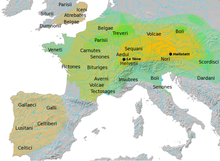
Back حضارة هالستات Arabic حضارة هالستات ARZ Гальштацкая культура Byelorussian Халщатска култура Bulgarian Halštatska kultura BS Cultura de Hallstatt Catalan Doba halštatská Czech Y diwylliant Hallstatt Welsh Hallstattkulturen Danish Hallstattzeit German
 | |
| Geographical range | Europe |
|---|---|
| Period | Late Bronze Age, Early Iron Age |
| Dates | 1200 – 450 BC Hallstatt A (1200 – 1050 BC); Hallstatt B (1050 – 800 BC); Hallstatt C (800 – 650 BC); Hallstatt D (620 – 450 BC) |
| Type site | Hallstatt |
| Preceded by | Urnfield culture |
| Followed by | La Tène culture |
The Hallstatt culture was the predominant Western and Central European archaeological culture of the Late Bronze Age (Hallstatt A, Hallstatt B) from the 12th to 8th centuries BC and Early Iron Age Europe (Hallstatt C, Hallstatt D) from the 8th to 6th centuries BC, developing out of the Urnfield culture of the 12th century BC (Late Bronze Age) and followed in much of its area by the La Tène culture. It is commonly associated with Proto-Celtic speaking populations.
It is named for its type site, Hallstatt, a lakeside village in the Austrian Salzkammergut southeast of Salzburg, where there was a rich salt mine, and some 1,300 burials are known, many with fine artifacts. Material from Hallstatt has been classified into four periods, designated "Hallstatt A" to "D". Hallstatt A and B are regarded as Late Bronze Age and the terms used for wider areas, such as "Hallstatt culture", or "period", "style" and so on, relate to the Iron Age Hallstatt C and D.
By the 6th century BC, it had expanded to include wide territories, falling into two zones, east and west, between them covering much of western and central Europe down to the Alps, and extending into northern Italy. Parts of Britain and Iberia are included in the ultimate expansion of the culture.
The culture was based on farming, but metal-working was considerably advanced, and by the end of the period long-range trade within the area and with Mediterranean cultures was economically significant. Social distinctions became increasingly important, with emerging elite classes of chieftains and warriors, and perhaps those with other skills. Society is thought to have been organized on a tribal basis, though very little is known about this. Settlement size was generally small, although a few of the largest settlements, like Heuneburg in the south of Germany, were towns rather than villages by modern standards. However, at the end of the period these seem to have been overthrown or abandoned.